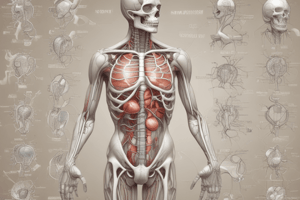Podcast
Questions and Answers
Which anatomical plane corresponds to the movement of shoulder abduction and adduction?
Which anatomical plane corresponds to the movement of shoulder abduction and adduction?
- Transverse
- Lateral
- Coronal/Frontal (correct)
- Sagittal
What is the anatomical term for a body part that is closer to the midline?
What is the anatomical term for a body part that is closer to the midline?
- Distal
- Proximal
- Medial (correct)
- Lateral
Which system is responsible for the rapid communication of information throughout the body?
Which system is responsible for the rapid communication of information throughout the body?
- Nervous System (correct)
- Skeletal System
- Integumentary System
- Endocrine System
What is the primary function of the respiratory system?
What is the primary function of the respiratory system?
Which anatomical movement is used to describe the motion of turning the head from side to side?
Which anatomical movement is used to describe the motion of turning the head from side to side?
The wrist is ______ to the elbow.
The wrist is ______ to the elbow.
Which axis of rotation is associated with sagittal plane movements?
Which axis of rotation is associated with sagittal plane movements?
Which of the following correctly describes the anatomical position?
Which of the following correctly describes the anatomical position?
Which of these is the correct anatomical term for 'toward the back'?
Which of these is the correct anatomical term for 'toward the back'?
Which of these systems is responsible for removing metabolic waste products from the body?
Which of these systems is responsible for removing metabolic waste products from the body?
Flashcards
Nervous System
Nervous System
The system consisting of the brain and spinal cord, responsible for rapid responses.
Endocrine System
Endocrine System
A system that uses hormones for communication, leading to slower responses.
Anatomical Position
Anatomical Position
A standard position of the body, with palms facing forward.
Medial
Medial
Signup and view all the flashcards
Flexion
Flexion
Signup and view all the flashcards
Abduction
Abduction
Signup and view all the flashcards
Sagittal Plane
Sagittal Plane
Signup and view all the flashcards
Coronal Plane
Coronal Plane
Signup and view all the flashcards
Transverse Plane
Transverse Plane
Signup and view all the flashcards
Proximal
Proximal
Signup and view all the flashcards
Study Notes
Chapter 3: Systems Approach
- Course: EXS-210
- Instructor: Dr. Michelle "Twitch" Jilek, PT, DPT, OCS, CSCS
The Systems
- Nervous System: brain and spinal cord, rapid response
- Endocrine System: hormones, slow response
- Respiratory System: lungs, breathing
- Circulatory System: heart, transport
- Integumentary System: skin, body temperature regulation
- Muscular System: muscles, tendons
- Skeletal System: skeleton, structure, ligaments
- Immune System: protection, repair
- Energy System: aerobic and anaerobic pathways
- Digestive System: pathway of food/nutrients
- Urinary System: removes waste, fluid volume regulation
- Reproductive System: perpetuation of the species
Anatomical Position
- Palms forward
Anatomical Planes
- Sagittal: right and left halves, example hip flexion/extension, X-axis (think roasting on a spit)
- Coronal/Frontal: front and back halves, example shoulder abduction/adduction, Z-axis
- Transverse: top and bottom halves, example head turning, Y-axis (think top spinning)
Anatomical Directions
- Midline
- Medial/lateral
- Superior/inferior
- Anterior/posterior
- Superficial/deep
- Proximal/distal
- Caudal/rostral
- Dorsal/ventral
Anatomical Movements
- Flexion/extension
- Abduction/adduction
- Internal/external rotation
- Other movements like: Lateral flexion, rotation, elevation, depression, dorsi/plantar flexion, inversion/eversion are shown in the figure
Additional Points
- Name examples of body parts in relation to each other (e.g., wrist is distal to the elbow, sternum is medial to the shoulder, eyes are superior to chin).
- Identify which anatomical movements go with specific anatomical planes and axes. A demo is likely to follow to show applied examples.
Studying That Suits You
Use AI to generate personalized quizzes and flashcards to suit your learning preferences.




